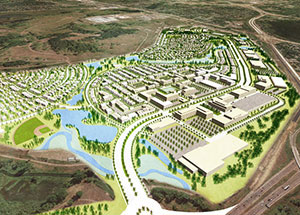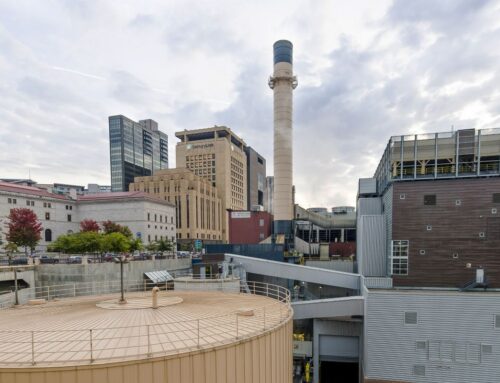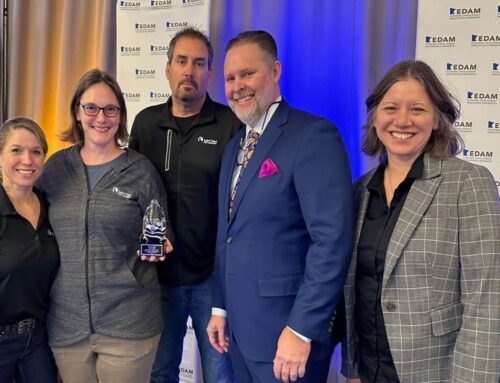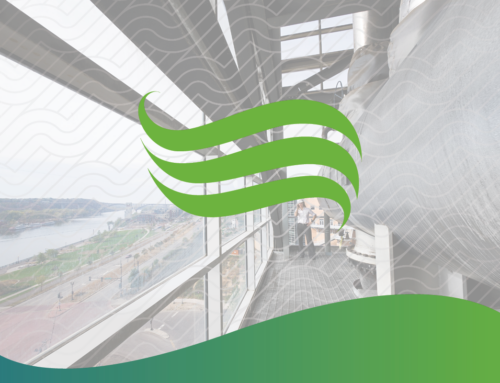
Energy Planning from Brownfield to Sustainable Redevelopment
June 19, 2015 by Ever-Green Energy
Planners, developers, businesses, and regional stakeholders are prioritizing localized energy solutions and technologies in their redevelopment planning. Although these solutions work in many applications, brownfields are the ideal place to develop, test, and demonstrate innovative energy solutions. And now is the ideal time to imagine the possibilities.

Rendering of vision for Rice Creek Commons. Image courtesy of Ramsey County
Brownfields offer a blank canvas without the hindrances of working in an existing neighborhood, which allows for innovative energy choices while not affecting service availability or stranding existing utility assets. Brownfields provide the opportunity for communities to think creatively to develop, test, and demonstrate new ideas about energy generation and delivery without working around existing obstacles. The process of transforming underutilized and often polluted land into vibrant and sustainable neighborhoods provides unique opportunities to build great places to live, work, and play while testing solutions that can be implemented more broadly throughout the city. During site demolition and environmental remediation, brownfields are often stripped of all infrastructures, including energy assets. This means that developers have an opportunity to install new utility infrastructure on a clean site, expanding the possibilities of design and technology while reducing cost through infrastructure construction coordination, such as sewer and streets.
More than ever, residents and businesses are considering the economic and environmental benefits of including sustainability in their decision-making, and sites that feature energy innovation can attract residents and companies. Some brownfield (or greenfield) redevelopments offer uniquely urban sites, that can be near amenities, transportation, and workforce, which makes the property more valuable and marketable once developed. These sites are ideal for the integration of energy efficient systems like district energy, combined heat and power, and solar alongside advanced demand-side management strategies that include building design, smart systems, and load reduction practices. Beyond energy, additional sustainability practices might include bike paths and public transportation, designated green public space, storm water reuse, and waste reduction and recycling. Integrating these solutions into a site offers carbon reductions and cost-savings to occupants and creates a unique offering in the real estate market.
In Arden Hills, MN, Ever-Green Energy is leading a team with expertise in energy systems and planning for a former army ammunition plant, now under development as Rice Creek Commons, through the leadership of Ramsey County, Arden Hills, and neighborhood partners. The vision is to transform this long-dormant brownfield into a vibrant development that leverages long-term energy strategies and infrastructure to attract investment and partnership, achieving sustainable benefits for Arden Hills and the surrounding community. With planning and leadership, this area can be developed to utilize economically competitive, low-carbon energy sources while following exceptional energy efficiency practices that engage site developers and future residents.
Another interesting Minnesota project is the redevelopment of a former Ford assembly plant, which occupied 125 acres and is now a major opportunity for the City of Saint Paul and its stakeholders. I have been granted the opportunity to serve on the Ford Site Energy Study Technical Advisory Group. Similar to Rice Creek Commons, the Ford site offers a great opportunity to integrate renewable and efficient energy sources along with efficient buildings and standards to minimize energy use and reduce greenhouse gas emissions. By making sustainable energy planning a priority in brownfield redevelopment, communities can demonstrate advanced energy solutions and efficiency practices that can be incorporated into other neighborhoods, including ones with existing energy infrastructure.
There are many examples of projects that showcase what is possible and have led the way for the projects we are planning and advising. Southeast False Creek in Vancouver, BC exemplifies the energy innovation potential in brownfield redevelopment. In 2003 the area was an 81 acre industrial brownfield, and today it has been transformed into a LEED platinum, mixed use neighborhood. Home to 12,000 residents, False Creek features great amenities, urban agriculture, highly efficient buildings, and an innovative district energy system that gets 70% of its energy from a heat exchange with the city’s sewage system. This technology solutions is gaining attention throughout North America and has proven itself viable for another of our developing projects, the University Avenue District in the Prospect Park neighborhood of Minneapolis, Minnesota.
These types of innovations are made possible by the blank canvas devoid of infrastructure which are uniquely found within brownfields. During a recent trip that I took that was focused on energy innovation, each featured project in Sweden, Denmark, and Germany was developed on a former brownfield. We can use these redevelopment opportunities to repurpose, to lay foundations, and to imagine solutions that meet the needs and goals of communities today and into the future. This is an important way for communities to achieve reliable energy solutions, sustainability, and resilience.
In June, I will return to Germany for the Berlin Seminar on Energy Policy. This is another way for our team and other local partners to learn about what is possible and apply these best practices for brownfields, greenfields, and other development and improvement opportunities. I look forward to sharing more from that trip in my next blog post.
If you are attending the IDEA Conference and would like to learn more about energy planning opportunities, Michael Ahern, Ever-Green’s Senior Vice President of Project Development, will be presenting on Tuesday, June 30, on brownfield infrastructure opportunities in the morning and on the 4th generation of district energy systems in the afternoon.




